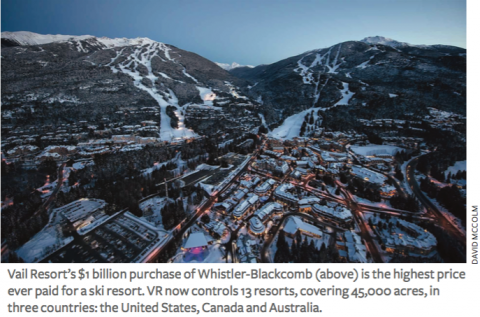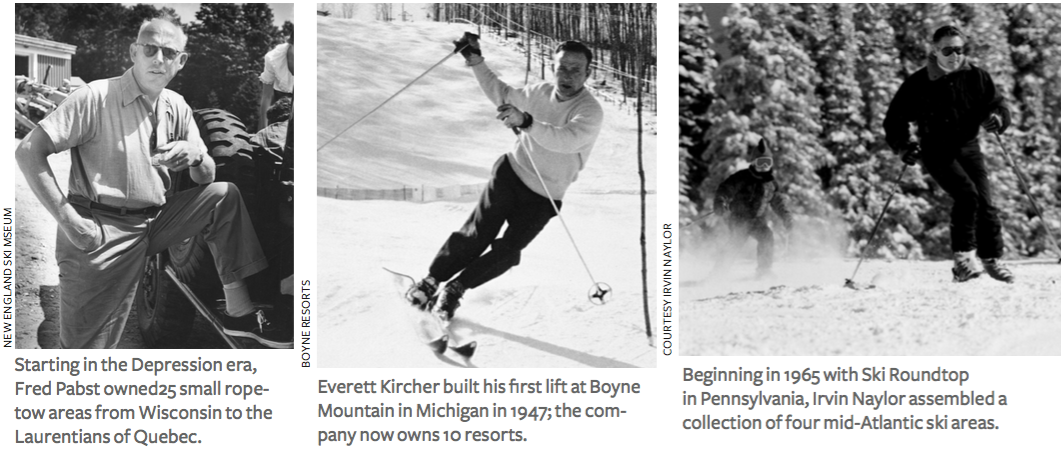
Vail’s purchase of Whistler/Blackcomb is historic: it makes the company twice as large, financially, as the number two ski resort operator. Vail is now poised to leap oceans.
By Seth Masia
When, in August, Vail Resorts (VR) announced its $1 billion dollar purchase of Whistler-Blackcomb (WB), the company solidified its position as the largest ski resort operation in North America, the second-largest in the world by acreage—and by a long shot the largest in the world in terms of revenue.
A billion dollars actually understates the scale of this deal. It’s the highest price ever paid for a ski resort, anywhere in the world. Because VR is buying a 75 percent stake (Nippon Cable holds the remaining 25 percent), WB is worth a bit over $1.3 billion. The resort has more than tripled in value since going public in 2010.
Whistler’s value to Vail is threefold,
according to Hugh Smythe, former WB president: WB is profitable all summer (unique among mountain resorts); it’s therefore a hedge against global warming; and it opens access to world markets, especially the fast-growing East Asia market.
Vail began expanding in 1980 with the opening of Beaver Creek. With this acquisition, VR controls 13 resorts, covering about 45,000 acres (18,000 ha) in three countries—the United States, Canada and Australia. In extent, that’s second only to Compagnie des Alpes (CdA), which manages 11 ski resorts in France covering more than 125,000 acres (50,000 ha).
The story of ski-resort empires begins with Fred Pabst, who scattered rope tows about the northeastern quarter of North America during the Depression era. At one time or another, Pabst owned 25 ski areas, most using a single rope tow or T-bar, spread out between Wisconsin and Quebec’s Laurentians. During World War II, Pabst discovered he couldn’t personally supervise all his small fiefdoms, and consolidated at Big Bromley, Vermont. Since then, notable ski-empire entrepreneurs have included:

- Everett Kircher, who built his first lift at Boyne Mountain, Michigan in 1947. Boyne Resorts now manages about 14,884 acres (5,953 hectares) of lift-served terrain at 10 resorts—including Big Sky, Montana; Crystal Mountain, Washington; and Sugarloaf, Maine.
- Aspen Skiing Company, beginning in 1948, which today operates four neighboring lift networks on 5,306 acres (2,122 ha).
- Irv Naylor, who assembled a collection of four mid-Atlantic ski areas beginning with Ski Roundtop in Pennsylvania in 1965.
- George Gillette, who morphed from owning Vail to operating the nine Booth Creek Resorts, including Waterville Valley and Grand Targhee. At its peak in 1997, the company operated on 9,431 acres (3,772 ha).
- Powdr Corp., a.k.a. the Cumming family, which acquired Nick Badami’s properties (Alpine Meadows and Park City) and today operates seven resorts totaling 9,600 acres (3840 ha).
- Charlie Locke, who built Resorts of the Canadian Rockies beginning in 1974. Today the company manages six resorts covering about 4,000 acres (1,600 ha).
- Tim Boyle at Peak Resorts, with a string of small and mid-size ski areas from Missouri to Maine, including Attitash, Hunter and Mt. Snow.
- Les Otten, who began with Sunday River in 1980 and by 1998 controlled about 23,000 acres (9,200 ha) through the American Skiing Company. The company folded in 2008.
- And of course Joe Houssian’s Intrawest, which acquired Blackcomb in 1986 and at its peak, in 2003, ran lifts on 25,000 acres (10,000 ha) plus about 3.2 million acres (12,348 square kilometers) of heliski terrain through its subsidiary Canadian Mountain Holidays.
The newly expanded VR enters an entirely different realm in financial terms. With WB on board, the corporation is on track to post more than $1.65 billion in revenue for the 2017–18 season, on more than 10.6 million skier-days. It’s roughly 15 percent of all skier days in North America.
And the revenue is twice what Compagnie des Alpes realizes (695.6 million euros, or $785 million) on fewer skier days (CdA reports 13.6 million). CdA gets only lift-ticket revenues, while VR also has profitable food service, ski school and retail/rental operations. But for a number of years, Vail also has pursued a savvy pricing strategy, pushing same-day ticket-window purchases steadily higher to make the company-wide season pass look more attractive. Faced with prices up to $175 for a day pass, even the ski-week customer feels obliged to spring for the $800 Epic Pass. Last year VR sold half a million season passes, valid at every resort within the realm. With Whistler in the mix, that’s likely to go past 700,000. A senior resort executive, declining to be identified, estimates that will be around 40 percent of all season passes sold in North America. According to Kelly Ladyga, VP of corporate communications at VR, the season pass program now constitutes 40 percent of the company’s ticket sales, and 15 percent of VR revenue. As the pass grows more attractive, that’s likely to go higher.
The strategy: Lock in the market share. Keep Epic Pass skiers travelling within the VR empire (VR commands about 43 percent of all Colorado skier days). Once you have the Epic Pass, how likely are you to pay the day-ticket price at Sun Valley or Jackson Hole or Telluride? Seeking an answer to that question, those resorts—along with Alta, Snowbird, Aspen/Snowmass, Mammoth, Squaw Valley/Alpine Meadows, Stowe, Taos, Lake Louise, Sunshine, Revelstoke, Thredbo and Coronet/Remarkables—have ganged together to offer the $409 Mountain Collective Pass, which offers two days of skiing at each resort, plus a 50 percent discount on additional days. The Collective might try to match the Epic Pass value, by expanding the number of days at each resort while bumping up the price. The Vail-Whistler deal won’t close until the end of 2016 and Whistler won’t join the Epic Pass program until the 2017-18 season. So the rest of the industry has about 18 months to come up with an effective response.

Meanwhile, VR wants even more growth. It’s reaching market-share saturation in North America, not to mention testing the limits of the U.S. anti-trust laws. Europe beckons, as does Japan. And so, on September 1, the company announced that the Epic Pass will be good for two or three days of skiing at each of 31 ski areas in Europe, covering Austria’s Arlberg region (including St. Anton), the entire Vanoise region in France (Val d’Isère, Les Arcs/La Plagne and the Trois Vallées complex), the Verbier region in Switzerland, and the Dolomites in Italy (each resort has its own rules for Epic Pass access—check http://tinyurl.com/EpicEurope for details). Europe’s resorts customarily exaggerate their acreage, but a rough count puts the terrain at 170,000 hectares (425,000 acres). For the North American skier with airline miles to burn, that certainly amps up the value of the pass. And for European skiing, it looks like Vail has secured a beachhead.

